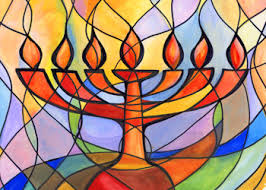
14 Jun Beha alotcha; Lighting a Candle… the Menorah , the Chanukiah
 The Menorah- (Parsha Beha’alotcha)
The Menorah- (Parsha Beha’alotcha)
Inspired by the teachings of Chassidut and Kabbalah of HaRav Yitzchak Ginsburgh and Rabbi Moshe Genuth
G‑d spoke to Moses, saying: Speak to Aaron and say to him, “When you raise (“beha’alotecha”) the lamps [of the Tabernacle’s candelabra]…”—Numbers 8:1-2.
Beha’alotecha is translated as “when you kindle,” which literally translates as “when you raise”, as in when the flame rises up, showing an intimate connection with last weeks parsha Naso.
Aaron had a specific duty in his service in the Mishkan. It was Aaron who completed the Menorah by lighting and thus inaugurating the Menorah. Although it was a mitzvah to build the Menorah, it was deemed a separate Mitzvah that Aaron light and inaugurate the Menorah. Each time the Menorah was lit, it was Aaron’s specific duty to clean, assemble, add olive oil and light the menorah. Each time the Menorah was re-assembled and lit, it was considered as a new Menorah (as is the lighting of the Chanukiah), and a ‘new’ mitzvah and has been carried throughout the journey of the exile to the coming of Mashiach.
It is our teaching that every mitzvah, even when done repeatedly is new each time as we are new and continually recreated (reborn) through service to G-d.
There is a powerful connection between Aaron lighting the menorah and the Shema. The Hebrew word for flame is ‘shelhavet’ and has a gematria (numerical value) of 737. In the Shema, we say ‘with all your heart, and with all your soul, and with all your might.” (B’chol levavcha, uvechol nafshecha uvechol me’odecha). The numerical value of this phrase is also 737. Both share the concept of raising up.
When we light one candle from another we ought not touch the wicks together but allow the unlit wick the opportunity to gently ‘receive’ the flame from the lit candle (shamos). It is when the flame is ‘received’ by the newly lit candle; accepted and transferred, and both flames are burning independently strong that they (their flames) then unite and rise high, giving birth to one united strong flame. Then, the candle has been properly lit.
The original flame (commonly known as the shamos [on Chanukah] ) ‘gives’ light to the unlit candle, and the candle to be lit ‘receives’ it (in an action referred to in Chassidut as touching -yet not- touching). The key to the unity and power of one single unified flame is that the candles are both equally givers and receivers … and they do so simultaneously. This ‘courtship of the candles’ is a metaphor for many interactions in life. Like a husband and wife who individually and together form one new nishama of unity (yichud), or like one Jew helps to ignite the light within the heart of another Jew, to nurture him to burn bright and strong. The first step to unity is we must bring someone close with loving kindness in order the sparks within them may be ignited and that they may receive the light.
We must look to touch every Jew to help him to ignite the spark within, and we must nurture him until his spark becomes a strong independent flame. We must be strong individually and together.
nb; the menorah has 7 candles, the Chanukiah has 8 candles (plus a shamos)
Leib Getzel (Lawrence) Lax
Addictions and Counseling (Honours)
www.lawrencelax.com
http://AuraOfTorah.com